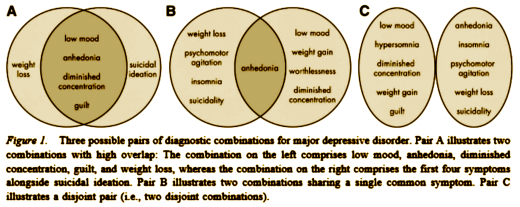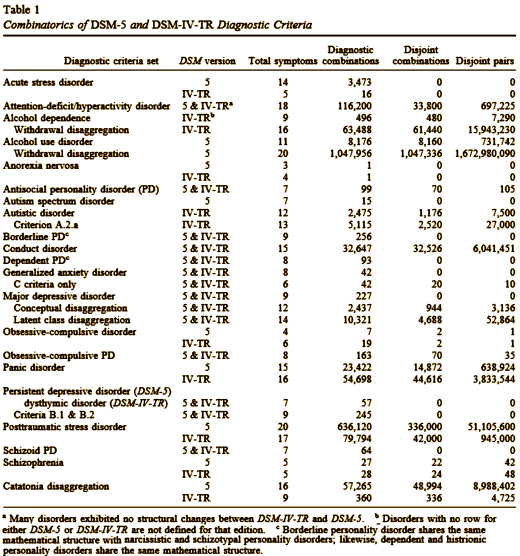by Eiko I. Fried and Randolph M. NesseJournal of Affective Disorders. 2014 172C:96-102.
-
A monothetic class is defined in terms of characteristics that are both necessary and sufficient in order to identify members of that class. This way of defining a class is also termed the Aristotelian definition of a class.
-
A polythetic class is defined in terms of a broad set of criteria that are neither necessary nor sufficient. Each member of the category must possess a certain minimal number of defining characteristics, but none of the features has to be found in each member of the category. This way of defining classes is associated with Wittgenstein’s concept of "family resemblances."
by Charles Olbert, Gary Gala, and Larry TuplerJournal of Abnormal Psychology. 2014 123[2]:452-62.
Heterogeneity within psychiatric disorders is both theoretically and practically problematic: For many disorders, it is possible for 2 individuals to share very few or even no symptoms in common yet share the same diagnosis. Polythetic diagnostic criteria have long been recognized to contribute to this heterogeneity, yet no unified theoretical understanding of the coherence of symptom criteria sets currently exists. A general framework for analyzing the logical and mathematical structure, coherence, and diversity of Diagnostic and Statistical Manual diagnostic categories [DSM-5 and DSM-IV-TR] is proposed, drawing from combinatorial mathematics, set theory, and information theory. Theoretical application of this framework to 18 diagnostic categories indicates that in most categories, 2 individuals with the same diagnosis may share no symptoms in common, and that any 2 theoretically possible symptom combinations will share on average less than half their symptoms. Application of this framework to 2 large empirical datasets indicates that patients who meet symptom criteria for major depressive disorder and posttraumatic stress disorder tend to share approximately three-fifths of symptoms in common. For both disorders in each of the datasets, pairs of individuals who shared no common symptoms were observed. Any 2 individuals with either diagnosis were unlikely to exhibit identical symptomatology. The theoretical and empirical results stemming from this approach have substantive implications for etiological research into, and measurement of, psychiatric disorders.


Long ago, before the blood pressure cuff, doctors approximated blood pressure readings by feeling the "hardness of the pulse." Before the thermometer, fever was measured with the back of the hand. Anemia was diagnosed by looking at the color on the back of the eyelid, and diabetes by tasting the urine. You do what you can do until something better comes along. What’s important is to know the precision and limits of the instrument, and not make more of it than it has to offer. The symptomatic, descriptive system worked in a few places, but was heavily overvalued in others. That was apparent on day one, yet it got reified and deified early on for reasons other than clinical accuracy. Worse, it was used by many to imply unproven unity and even etiology.
polythetic polymorphism = polymorphous perversity. Sorry I just couldn’t resist!
Mickey, I appreciate the publicity for the paper! I’ve been reading your blog for years and so it’s quite an honor.
When I got turned on to the issue of within-disorder heterogeneity, the problem had been mentioned for over 30 years (since DSM-III) but, surprisingly, had received very little attention in terms of empirical research. A few papers had calculated theoretically the number of ways to meet criteria for specific disorders, but virtually nobody had examined any disorder empirically, let alone provided a comprehensive treatment of the issue.
Perhaps the main contributions I see our paper making are (1) providing a framework for allowing cross-disorder comparisons as well as (2) documenting that the most extreme types of heterogeneity (disjoint pairs — when two individuals share the same diagnosis yet share no common symptoms) occurs in empirical reality, whether you use self-report data (a private dataset from the Jed Foundation) or structured-interview data (from the National Comorbidity Study).
I’d be happy to answer questions or discuss the issue further — but right now I have to run: believe it or not, this is the morning of my doctoral comprehensive examinations, and so I’ve got bigger fish to fry!
All the best,
Charles
Charles,
Good luck! And thanks for your article. It’s a real contribution…
Comorbid morbidity— why have just one diagnosis when there are so many overlapping possibilities and drugs to go with them.